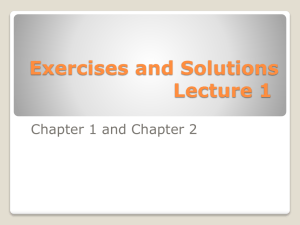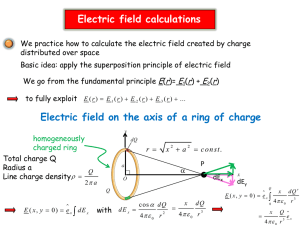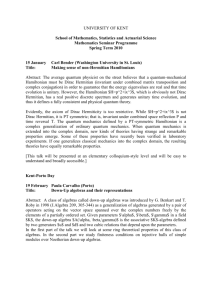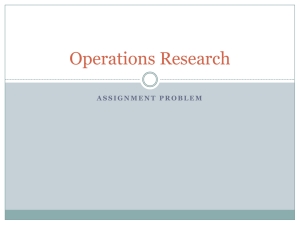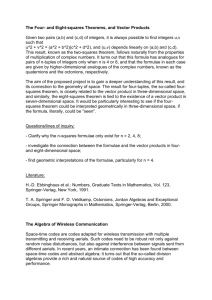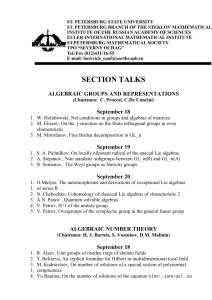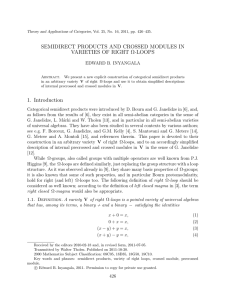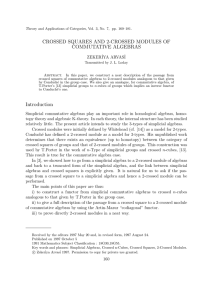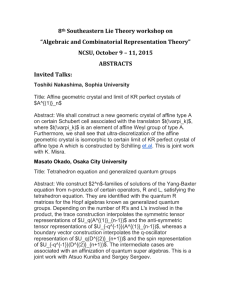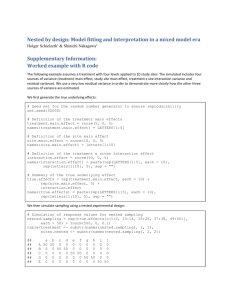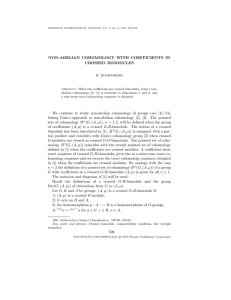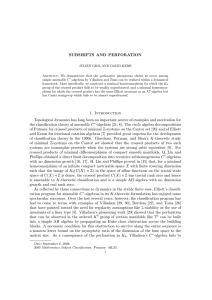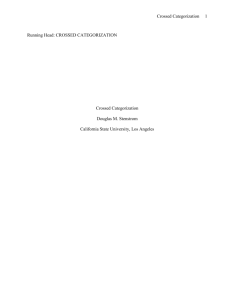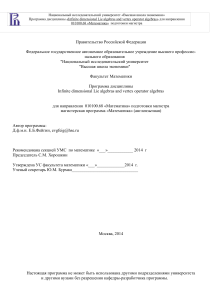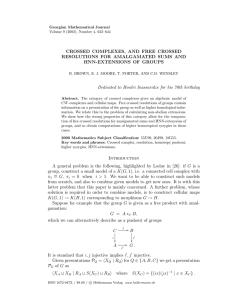Graded Algebras
advertisement
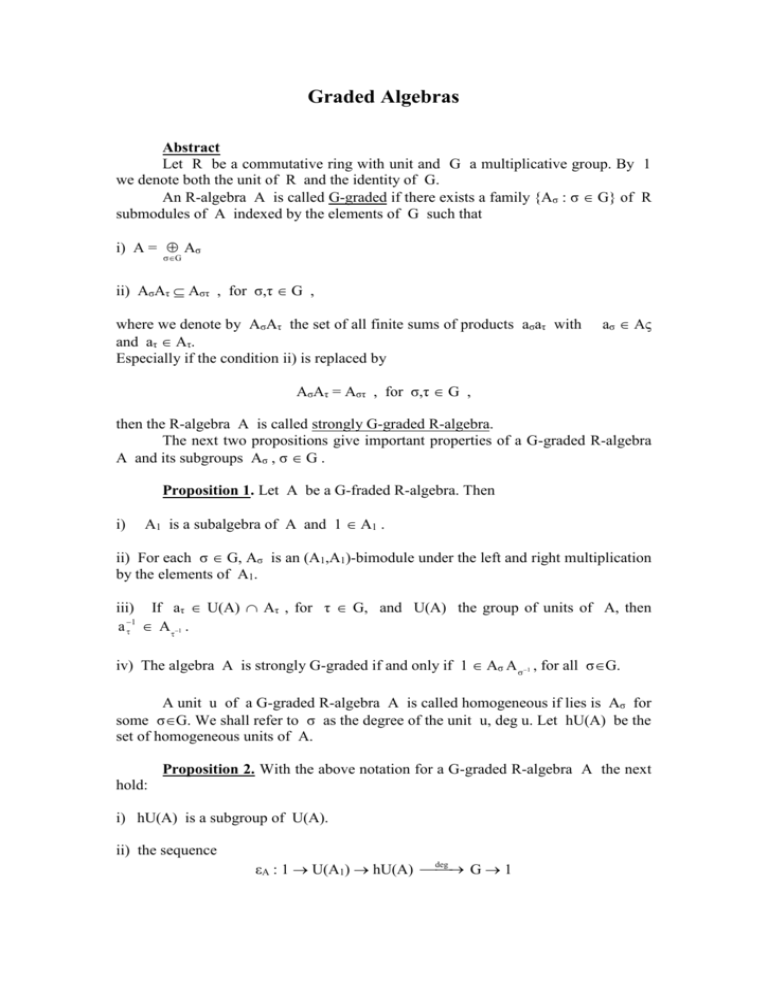
Graded Algebras
Abstract
Let R be a commutative ring with unit and G a multiplicative group. By 1
we denote both the unit of R and the identity of G.
An R-algebra A is called G-graded if there exists a family {Aσ : σ G} of R
submodules of A indexed by the elements of G such that
i) A = Aσ
G
ii) AσAτ Aστ , for σ,τ G ,
where we denote by AσAτ the set of all finite sums of products aσaτ with
and aτ Aτ.
Especially if the condition ii) is replaced by
aσ Ας
AσAτ = Αστ , for σ,τ G ,
then the R-algebra A is called strongly G-graded R-algebra.
The next two propositions give important properties of a G-graded R-algebra
A and its subgroups Aσ , σ G .
Proposition 1. Let A be a G-fraded R-algebra. Then
i)
A1 is a subalgebra of A and 1 A1 .
ii) For each σ G, Aσ is an (A1,A1)-bimodule under the left and right multiplication
by the elements of A1.
iii) If aτ U(A) Aτ , for τ G, and U(A) the group of units of A, then
a 1 1 .
iv) The algebra A is strongly G-graded if and only if 1 Aσ 1 , for all σG.
A unit u of a G-graded R-algebra A is called homogeneous if lies is Aσ for
some σG. We shall refer to σ as the degree of the unit u, deg u. Let hU(A) be the
set of homogeneous units of A.
Proposition 2. With the above notation for a G-graded R-algebra A the next
hold:
i) hU(A) is a subgroup of U(A).
ii) the sequence
deg
εA : 1 U(A1) hU(A)
G1
is exact at each place except possibly at G.
iii) the maps A1 Aσ , x
xuσ and A1 Aσ , x
uσx ,
where uσ U(A) Aσ are isomorphisms of left and right A1-nmodules respectively.
Examples:
1. Let S be a ring the polynomial ring S[x] is „-graded.
2. Let K be a field and E = K(a) where mink(a) = xn-k k[x]. The extension E/K
is a strongly „n-graded K-algebra.
3. Let S be an R-algebra, the K-algebra M3(S) is strongly „2-graded R-algebra
with
s s o
o o s
A o s s o and A1 o o s .
o o s
s s o
A strongly G-graded R-algebra A is called a crossed product of G under the
ring A1 , A = A1 G , if the sequence εa of Proposition 2 is exact. In particular if εa
is splitting, then A is called a skew group ring.
Proposition 3. Let A = Aσ be a strongly G-graded R-algebra. Then A
G
is a crossed product if and only if:
i) Ασ = Α1uσ , for some uσ U(A) Aσ , for all σ G
ii) the set {uσ : σ G} is an A1-basis of A
iii) there exist two maps
φ : G Aut(A1) , φ(σ)(a) = σa
and
a : G G U(A1)
which satisfy the relations
x = uσ x u 1 , uσuτ = α(σ,τ)uστ
σ
ρ
α(σ,τ)α(ρ,στ) = α(ρ,σ)α(ρσ,τ)
(factor set)
σ
(τx) = α(σ,τ) στx α(σ,τ)-1 ,
for ρ,σ,τ G , x A1.
Let us denote this crossed product by (G,A1,φ,α).
Example. Let S be a ring with unit, H a group and N a normal subgroup of
H. Then the group ring SH becomes a crossed product (SN) G, where G = H/N.
Let L/K be a Galois field extension with Galois group
G = AutK(L). The crossed product
G, that is
A = Luσ = (L,G,φ,α) ,
G
where φ is the identity, is called a classical crossed product.
The classical crossed products appeared firstly in the study of division
algebras.
By the celebrated Albert-Brauer-Hasse-Noether Theorem, every division
algebra over an algebraic number field is a crossed product (1932). In 1972
S.A.Amitsur discovered the first noncrossed product division algebra. His example, a
universal division algebra, is built from a ring of generic matrices over a field.
In 1995 E.Brussel proved that there are division algebras over K(x), where K
is an algebraic number field which are non crossed products.
References.
C.Năstăsescu and F.Van Oystaeyen. Methods of Graded rings, Springer, 2004
I.Reiner. Maximal Orders, Academic Press, 1975. Pierce Associative Algebras
S.A.Amitsur. On central devision algebras, Israel J.Mat. 12(1972), 408-422
E.Brussel. Noncrossed-products and nonabelian crossed products over …(T) and
…((T)), American J. of Math. 117(1995), 377-393.
---------------------------------------
Ισχυρά βαθμωτές ΄Αλγεβρες και Σταυρωτά γινόμενα
Περίληψη
Θα εξετασθούν
α) Ο ρόλος των σταυρωτών γινομένων στην μελέτη των αλγεβρών με διαίρεση.
β) Οι αναπαραστάσεις των ισχυρά βαθμωτών αλγεβρών και η σύνδεσή τους με τις
αναπαραστάσεις των πεπερασμένων ομάδων.



